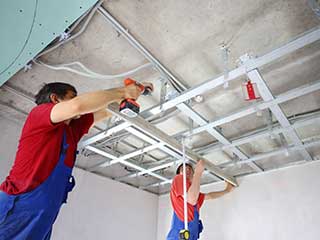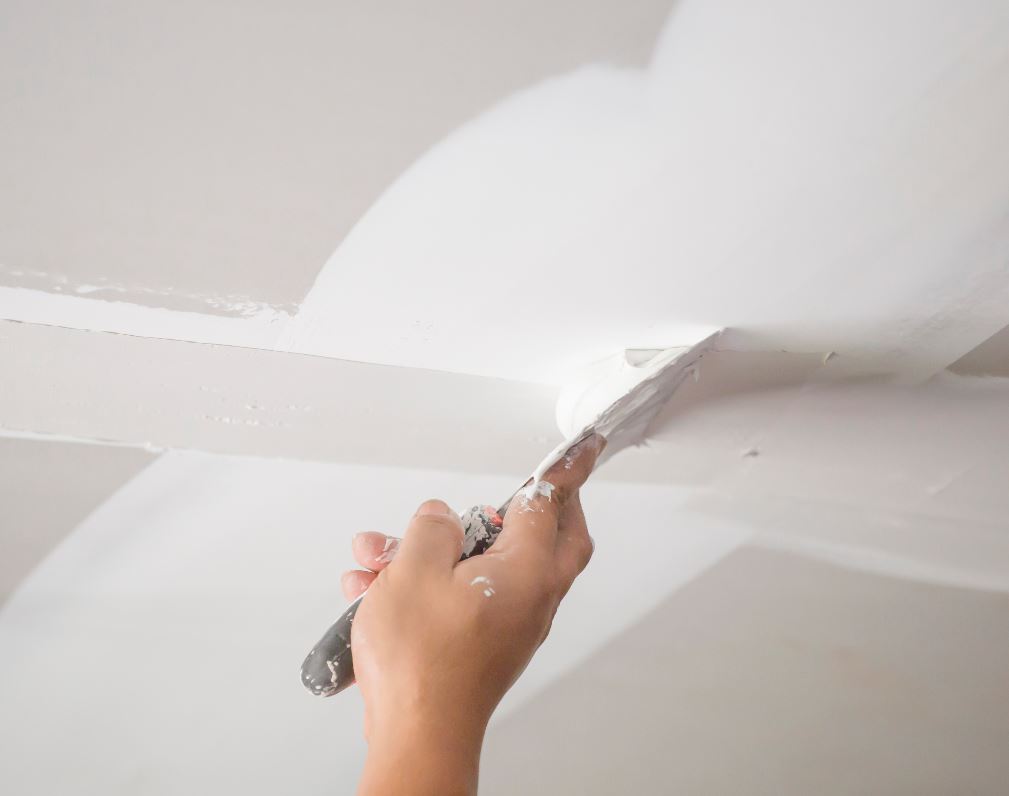A Comprehensive Guide to Mastering Drywall Repair and Installation
This overview supplies a thorough expedition of drywall repair work and installation, satisfying both newbies and skilled experts. It details vital devices, techniques for patching and hanging sheets, and the crucial ending up procedures. drywall contractor. By comprehending common mistakes, individuals can achieve polished results. Understanding these skills not just improves one's home yet likewise constructs confidence in DIY ventures. What foundational tips will assure an effective task from beginning to end?
Essential Tools for Drywall Fixing and Setup
When starting on drywall repair and setup, a few necessary tools can substantially enhance the efficiency and top quality of the work. A drywall knife, commonly readily available in numerous sizes, is essential for using joint compound and smoothing seams. A taping knife is additionally essential for feathering sides and guaranteeing a seamless finish. In addition, a drywall saw or energy blade permits for precise cutting of drywall sheets to fit any type of area.

Step-by-Step Guide to Patching Holes
Patching openings in drywall is an uncomplicated process that can recover the wall's appearance and honesty. To start, the location around the opening should be cleansed and any kind of loose debris got rid of. For tiny openings, an easy spackle or joint substance can be used with a putty knife. Bigger holes may call for a spot; an item of drywall can be cut to fit the hole, protected with glue or screws, and after that taped around the edges. When the spot remains in place, joint compound is applied over the spot and feathery bent on blend with the bordering wall. After the substance dries, fining sand is needed to attain a smooth surface. Ultimately, the repaired location can be keyed and painted to match the remainder of the wall. This technique ensures a smooth fixing, improving the general appearance of the drywall and maintaining its structural honesty.
Methods for Hanging Drywall Sheets
After successfully repairing openings in drywall, the following action entails hanging new drywall sheets to create a smooth surface area. To achieve this, one have to start by gauging the wall area accurately and reducing the drywall sheets to fit. It is important to hang the sheets horizontally for much better architectural integrity, beginning with the top and working downwards.
Utilizing a drywall lift can streamline the procedure, specifically for ceiling installations. Once positioned, protecting the sheets with drywall screws at periods of about 12 inches along the edges and 16 inches in the area is necessary. This ensures a firm hold and reduces the threat of drooping. For corners, the sheets must be reduced to fit comfortably, allowing for cleaner seams. Lastly, it is suggested to stagger the joints in between sheets to strengthen the overall framework, producing an extra durable coating prepared for the following stage in the drywall installment process.
Ending Up Touches: Taping and Mudding
Finishing the drywall installment entails the essential actions of mudding and taping, which assure a smooth and sleek finish. Taping requires the application of joint tape over the joints between drywall sheets. Drywall Repair Ogden go to this web-site UT. This tape can be either paper or fiberglass mesh, with each kind offering special benefits. After taping, the following action is mudding, where joint compound, or additional hints "mud," is applied to cover the tape and fill any imperfections
Making use of a drywall knife, the compound must be spread equally, guaranteeing a feathery side to lessen visible modifications. Several coats are often necessary, with sanding in between each layer to attain a smooth surface. Careful attention during this process is essential, as it significantly affects the final appearance of the wall surface. With the ideal technique and persistence, completion outcome will certainly be a remarkable foundation all view it set for paint or finishing touches.
Usual Errors to Stay Clear Of in Drywall Projects

One more typical mistake is not enabling sufficient drying out time in between coats, which can catch dampness and endanger the coating. In addition, ignoring to feather the sides properly can produce visible lines and blemishes. Skipping sanding or using inappropriate strategies may leave harsh spots. By being conscious of these challenges, individuals can substantially improve the top quality of their drywall tasks and achieve a professional-looking surface.
Regularly Asked Inquiries
Can I Fix Drywall Without Expert Help?
Yes, one can repair drywall without professional assistance. With the right tools, products, and support, individuals can efficiently deal with small fixings. However, substantial damages might require expert proficiency for optimal results and resilience.
For How Long Does Drywall Substance Require To Dry?
Drywall compound usually takes in between 24 to two days to dry totally, depending upon variables such as moisture and temperature level. Thinner layers may dry out faster, while thicker applications call for even more time for optimal results.
What's the very best Type of Paint for Drywall?
The most effective type of paint for drywall is usually a water-based latex paint. It provides excellent protection, toughness, and simplicity of application, making it suitable for interior wall surfaces while enabling very easy clean-up with soap and water.

How Do I Protect Against Mold on Drywall?
To stop mold and mildew on drywall, guarantee appropriate air flow, control humidity levels, use mold-resistant materials, and quickly deal with any leakages. Normal evaluations and immediate removal of water damages are additionally crucial for long-lasting prevention.
Is Drywall Recyclable After Removal?
Drywall is recyclable after elimination, gave it is without contaminants like mold and mildew, paint, or various other unsafe products. Recycling centers can process it into brand-new items, promoting sustainability and lowering land fill waste in building and construction.
When starting on drywall repair and installment, a couple of important tools can substantially boost the effectiveness and top quality of the work. After successfully fixing openings in drywall, the next action involves hanging new drywall sheets to create a smooth surface. Completing the drywall setup entails the crucial steps of taping and mudding, which assure a refined and smooth coating. Accomplishing a refined surface in drywall projects can be difficult, and several usual mistakes can undermine the quality of the work. Yes, one can fix drywall without expert aid.